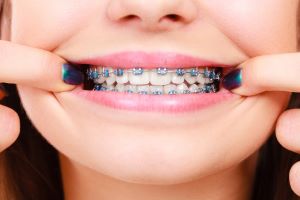Straight Talk: The Best Time for Braces

Is your child starting to lose baby teeth? If so, you might want to shift your focus from playing the tooth fairy to researching orthodontists.
Scheduling an examination for braces is probably not as fun as putting money under your child’s pillow, but based on new developments – as well as advice from the American Academy of Orthodontics (AAO) – an early visit to the orthodontist may prove advantageous.
Here is why making your child’s orthodontic needs a top priority right now is crucial to achieving the best smile possible.
The Health Benefits of Braces
Cosmetic improvements are an obvious benefit of getting braces, but there are also important health reasons for sporting them:
- Lower potential for decay, due to difficulty cleaning crooked or overlapping teeth
- Prevention of jaw-related problems, such as head and ear aches, or TMJ
- Improved ability to chew or speak, if bite problems were to blame
- Reduced risk of cardiovascular disease, which has been linked to poor dental health
In addition, correcting your child’s smile can help boost confidence and self-esteem, while saving you time and money by neutralizing potential health problems before they become serious.
When to Go and What to Expect
According to the AAO, children should see an orthodontist by the time they are seven years old. It is important to note, however, that this does not necessarily mean treatment has to start at this age.
Every practice is different, but common aspects of a first-time visit include:
- A thorough review and discussion of your child’s health and medical history
- X-rays, for a better understanding of various tooth positions and emerging teeth
- An oral exam for any tooth, jaw or bite misalignments/abnormalities
- Teeth impressions, for reference while determining the best treatment
- Treatment recommendation that may or may not include braces
Regardless of your child’s dental situation, timing is everything. Early detection of certain problems may increase your options for treatment.
Differing Approaches to Braces
When caught early enough, certain tooth misalignments can be addressed via a method typically referred to as an “interceptive approach”. This form of treatment occurs in two phases, the first of which involves orthodontic devices while the child still has baby teeth, followed by standard braces once he or she has a full set of permanent teeth. Proponents of this approach believe that acting early makes it easier to correct problems, and also tout the fact that treatment will be finished at a younger age.
On the other hand, the traditional approach to braces doesn’t start until all permanent teeth have emerged, which can happen anywhere between the ages of 8-14 (even though assessment at an early age is still recommended). Advocates of this form of treatment highlight that overall time spent wearing orthodontic devices is shorter, the cost may be less expensive, and similar results are usually achieved.
The Best Course of Action
Decisions on timing and treatment are up to the parent, but having your child’s mouth examined early can make the choices easier, especially if there are severe misalignments.
Select your orthodontist carefully, and don’t be afraid to schedule a consultation in advance to find out if his or her philosophy is right for you and your child.
Sources:
Braces For Young Kids Might Not Always Be Best. (n.d.). Retrieved June 7, 2015, from http://www.npr.org/templates/story/story.php?storyId=130073442
Dowshen, S. (2014, August 1). The Basics of Braces. Retrieved June 7, 2015, from http://kidshealth.org/parent/general/teeth/braces.html
Kids Getting Braces Younger and Younger. (2009, October 23). Retrieved June 7, 2015, from http://www.nbcnews.com/id/33434473/ns/health-childrens_health/t/kids-getting-braces-younger-younger/#.VWvHj2TBzGc
Salinas, T. (2014, May 21). Dental Braces. Retrieved June 7, 2015, from http://www.mayoclinic.org/tests-procedures/braces/expert-answers/dental-braces/faq-20058192